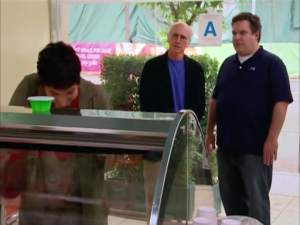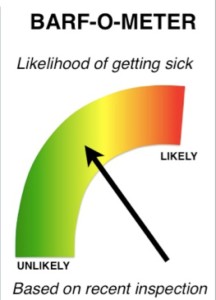Unlike many other cities, Guelph (that’s in Canada) doesn’t require places that serve food to post their health inspection results on their premises.
 A Mercury survey of the 460 food establishments that had health code violations at their most recent inspection found that Public Health Wellington-Dufferin-Guelph flagged 152 eateries for having violations that could cause food poisoning.
A Mercury survey of the 460 food establishments that had health code violations at their most recent inspection found that Public Health Wellington-Dufferin-Guelph flagged 152 eateries for having violations that could cause food poisoning.
These violations included food handlers not washing their hands, toxic substances not being stored separately from food, and food not being refrigerated properly, data from public health’s own website show.
And barely half of those with serious health code violations post a simple sign at their establishment telling people where to find the inspection results online through the health unit’s “Check Before you Choose” database.
Jessica Morris, manager of health protection with Wellington-Dufferin-Guelph Public Health, said officials try to use the sign as a “sales pitch” to owners, saying it demonstrates their commitment to food safety. She said the website is very well-frequented.
Morris added eateries with violations that could cause food poisoning are required to correct the problem within 72 hours. If there is an imminent health risk, public health closes the restaurant, which it has done in two cases since 2013.
 Wellington-Dufferin-Guelph Public Health started posting results of its food safety inspections online in early 2013.
Wellington-Dufferin-Guelph Public Health started posting results of its food safety inspections online in early 2013.
Before that, members of the public would have to contact public health to find out about the food safety record of their favourite diner or coffee shop.
As anyone who has ever spent the day doubled over in the bathroom after a meal can attest, food safety is no joke.
Many communities in Ontario, and around the world, go one step further than Wellington-Dufferin with a pass-fail system that requires restaurants to post their inspection results on their premises.
In Toronto, for example, consumers can easily see how a restaurant has fared on their most recent inspection through a system called DineSafe.
After an inspection, restaurants receive either a green (pass), yellow (conditional pass) or red (closed) sign, which they must post where guests can clearly see it.
A green sign is an easily understood stamp of approval: The food here is safe to eat.
Sylvanus Thompson, associate director at Toronto Public Health, said after the system was introduced in 2001 following a Toronto Star investigation on restaurant inspections, there was a 40 per cent decrease in instances of sporadic food poisoning in the city.
 He said officials can’t conclude the new system definitely caused this decline. But he said data show compliance of food establishments went from around 70 to over 90 per cent with the introduction of DineSafe.
He said officials can’t conclude the new system definitely caused this decline. But he said data show compliance of food establishments went from around 70 to over 90 per cent with the introduction of DineSafe.
“We know for sure that the yellow was playing a significant role in the increase in compliance,” Thompson said.
“They don’t want to get the yellow. They call it the fear of the yellow.”
A version of the model has been adapted by Peel Region, Durham Region, Halton Region, Hamilton, London, Lambton County, Sacramento County in California, Shanghai in China, and cities in Denmark and Scotland.
For food safety experts such as Doug Powell, a former food safety professor at the University of Guelph and Kansas State University who publishes “barfblog” about food- borne illness, such a change is long overdue.
“For a city that prides itself as the food and agricultural centre of the Canadian universe, their lack of public disclosure is pretty embarrassing I think,” he said, speaking from Brisbane, Australia, where he is now based.
“Toronto figured it out, cities around Toronto figured it out. New York City, Los Angeles have all figured it out,” he said.
New York and Los Angeles take a slightly different approach, making restaurants display letter grades. An “A” means all good, “B” and “C” less so.
Powell laughed when told Guelph eateries still don’t have to post their inspection results on the premises.
He acknowledges systems like DineSafe aren’t perfect. But he said they enhance the conversation about food safety, for both restaurants and the public.
Keith Warriner, a professor of food science at the University of Guelph, said even the best public disclosure systems have issues..
Results can vary according to whether an inspector has a bad day or lacks experience, he said.
More important, said Warriner, is making sure restaurant employees get proper training in food safety.
For Powell, the bottom line should be fewer people getting sick.
“That is the goal of public health and should be the message consistently, and (systems like Dinesafe) are a tool to reduce the number of sick people. Go for it.”
 The bill will be sent back to the Cabinet for its approval and then for presidential assent for implementation. The bill was passed by the Cabinet in March last year.
The bill will be sent back to the Cabinet for its approval and then for presidential assent for implementation. The bill was passed by the Cabinet in March last year.











